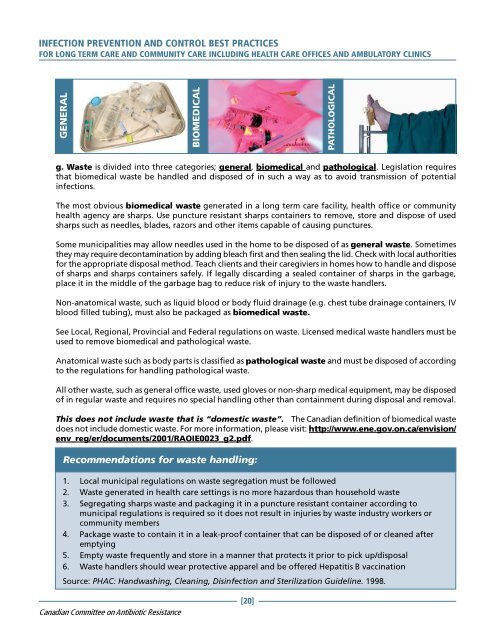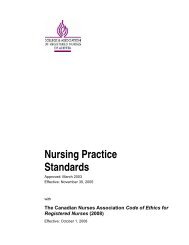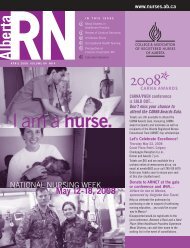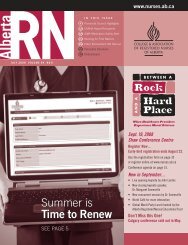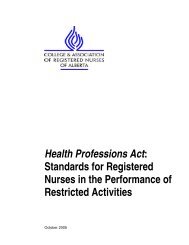Infection Prevention and Control Best Practices - College ...
Infection Prevention and Control Best Practices - College ...
Infection Prevention and Control Best Practices - College ...
Create successful ePaper yourself
Turn your PDF publications into a flip-book with our unique Google optimized e-Paper software.
INFECTION PREVENTION AND CONTROL BEST PRACTICES<br />
FOR LONG TERM CARE AND COMMUNITY CARE INCLUDING HEALTH CARE OFFICES AND AMBULATORY CLINICS<br />
GENERAL<br />
g. Waste is divided into three categories; general, biomedical <strong>and</strong> pathological. Legislation requires<br />
that biomedical waste be h<strong>and</strong>led <strong>and</strong> disposed of in such a way as to avoid transmission of potential<br />
infections.<br />
The most obvious biomedical waste generated in a long term care facility, health office or community<br />
health agency are sharps. Use puncture resistant sharps containers to remove, store <strong>and</strong> dispose of used<br />
sharps such as needles, blades, razors <strong>and</strong> other items capable of causing punctures.<br />
Some municipalities may allow needles used in the home to be disposed of as general waste. Sometimes<br />
they may require decontamination by adding bleach first <strong>and</strong> then sealing the lid. Check with local authorities<br />
for the appropriate disposal method. Teach clients <strong>and</strong> their caregiviers in homes how to h<strong>and</strong>le <strong>and</strong> dispose<br />
of sharps <strong>and</strong> sharps containers safely. If legally discarding a sealed container of sharps in the garbage,<br />
place it in the middle of the garbage bag to reduce risk of injury to the waste h<strong>and</strong>lers.<br />
Non-anatomical waste, such as liquid blood or body fluid drainage (e.g. chest tube drainage containers, IV<br />
blood filled tubing), must also be packaged as biomedical waste.<br />
See Local, Regional, Provincial <strong>and</strong> Federal regulations on waste. Licensed medical waste h<strong>and</strong>lers must be<br />
used to remove biomedical <strong>and</strong> pathological waste.<br />
Anatomical waste such as body parts is classified as pathological waste <strong>and</strong> must be disposed of according<br />
to the regulations for h<strong>and</strong>ling pathological waste.<br />
All other waste, such as general office waste, used gloves or non-sharp medical equipment, may be disposed<br />
of in regular waste <strong>and</strong> requires no special h<strong>and</strong>ling other than containment during disposal <strong>and</strong> removal.<br />
This does not include waste that is “domestic waste”. The Canadian definition of biomedical waste<br />
does not include domestic waste. For more information, please visit: http://www.ene.gov.on.ca/envision/<br />
env_reg/er/documents/2001/RAOIE0023_g2.pdf.<br />
Recommendations for waste h<strong>and</strong>ling:<br />
1. Local municipal regulations on waste segregation must be followed<br />
2. Waste generated in health care settings is no more hazardous than household waste<br />
3. Segregating sharps waste <strong>and</strong> packaging it in a puncture resistant container according to<br />
municipal regulations is required so it does not result in injuries by waste industry workers or<br />
community members<br />
4. Package waste to contain it in a leak-proof container that can be disposed of or cleaned after<br />
emptying<br />
5. Empty waste frequently <strong>and</strong> store in a manner that protects it prior to pick up/disposal<br />
6. Waste h<strong>and</strong>lers should wear protective apparel <strong>and</strong> be offered Hepatitis B vaccination<br />
Source: PHAC: H<strong>and</strong>washing, Cleaning, Disinfection <strong>and</strong> Sterilization Guideline. 1998.<br />
Canadian Committee on Antibiotic Resistance<br />
BIOMEDICAL<br />
[20]<br />
PATHOLOGICAL


